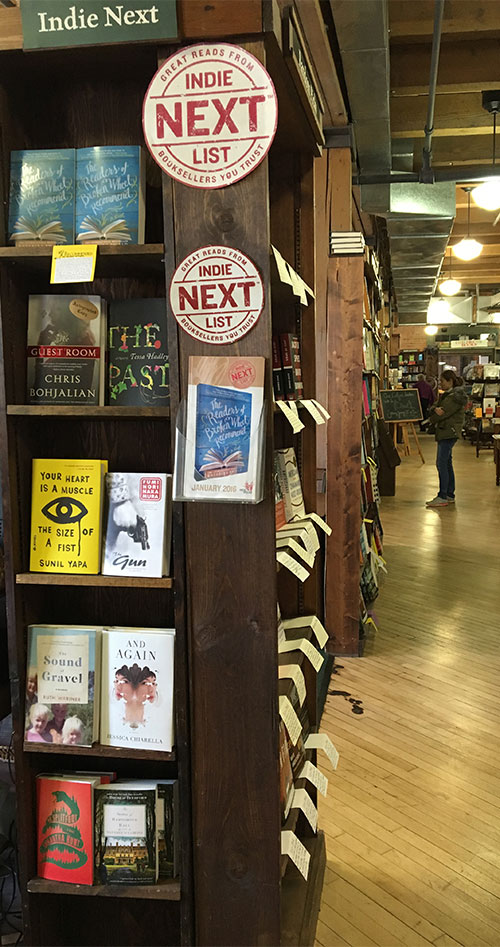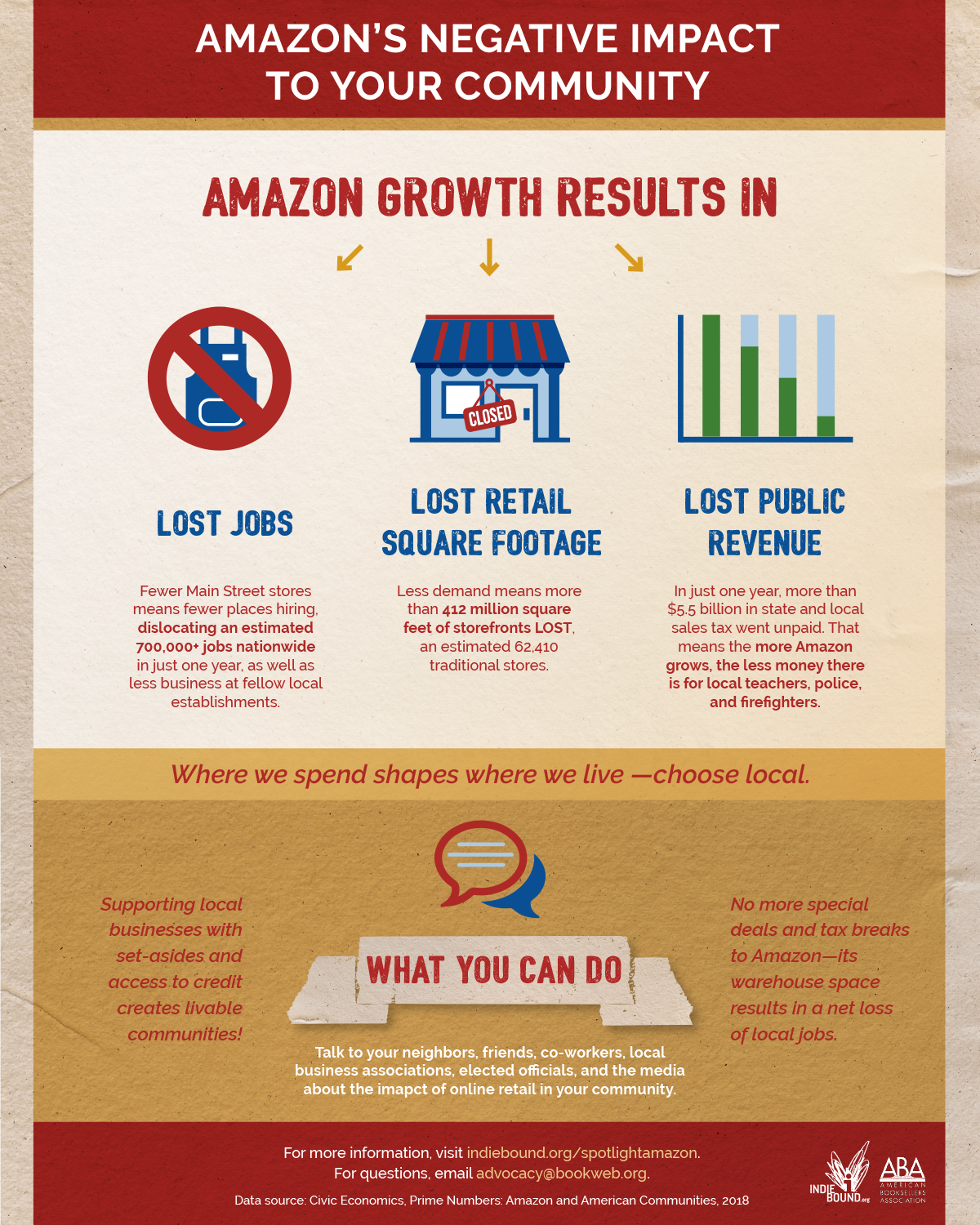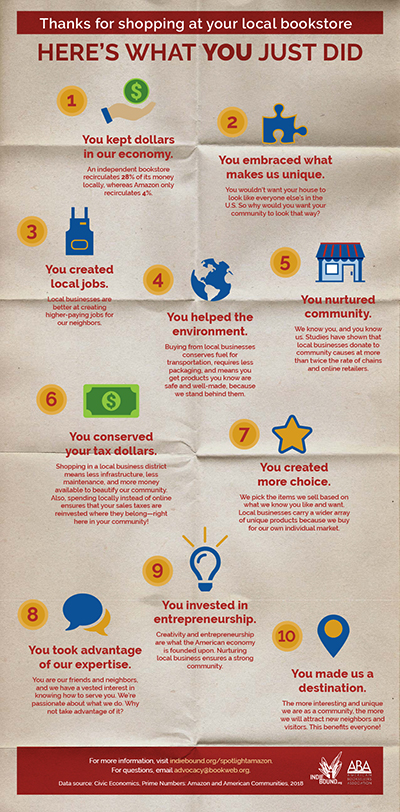Spotlight on Amazon
Spotlight on Amazon
The True Cost of Amazon Revealed
A recent report from economic analysis firm Civic Economics says that sales by Amazon and third-party vendors — in 2018 alone — accounted for $5.5 to $7 billion in uncollected sales tax. The report also estimates that in just one year Amazon sales displaced the equivalent of 540 million square feet of retail space and 900,000 retail jobs.
That lost revenue would have funded public works, public safety, and public education.
Prime Numbers: Amazon and American Communities was commissioned by the American Booksellers Association. The report concludes that despite the convenience Amazon provides, Americans may not comprehend the nature of the trade-off.
Another recent study, Home Sweet Home: Locals vs. Amazon, demonstrates the significant economic benefit that supporting independent businesses has on local communities. The study, conducted by Civic Economics and commissioned by the North American Retail Hardware Association (NRHA), the Paint and Decorating Retailers Association, and Independent We Stand, specifically compares the impact of conducting business with independent hardware stores versus the sales of hardware and building materials through Amazon. It shows the substantial “local advantage” of indie stores over Amazon in terms of re-circulation of revenue back into the community.
Additional Reading
How to Fight Amazon (Before You Turn 29)
Why Independent Bookstores Have Thrived in Spite of Amazon.com
Stacy Mitchell on Amazon's Stealth Invasion
Frequently Asked Questions

Q: Haven’t independent bookstores all gone out of business?
A: Not at all!
There has been a renaissance in indie bookselling over the past five years. While not every bookstore or community has seen this growth, the national trends are clear: New stores are opening. There has been a 35 percent increase in the number of independent bookstore locations since 2009, existing stores are opening in new locations, and established stores are being successfully sold to new owners, often younger owners as a new generation of booksellers enters the industry.
Importantly, too, book sales are up across the indie channel. There have been consistent, modest sales gains for four years, and sales were up approximately eight percent in 2015.
All of this is a result of the fact that indie booksellers are a resilient and entrepreneurial group, offering customers a unique opportunity to discover great new titles and a closer connection with authors, fellow readers, and their community.
Q: But what about other indie businesses?
A: Independent businesses of all kinds are seeing growth. Here are just a few examples of the health of independent businesses in the U.S.:
- Indie coffee shops are opening locations at one-and-a-half times the rate of Starbucks,
- Over the last 10-plus years, the number of farmers markets has grown from 3,000 to almost 8.000,
- More than 1,400 small grocery and speciality food stores have opened nationwide,
- More than 4,277 new restaurants have opened over the past four years,
- Locally owned inns and B&Bs have booked a record number of stays over the past five-plus years,
- And more than 300 new pet stores have opened!
Without a doubt, such mega-companies such as Walmart and Amazon have continued to grow, and competition remains fierce, but in contrast to the grim reports of the 1990s and early 2000s, the rise of the localism movement and other factors has resulted in gains for indie businesses.
Q: I hear a lot about localism, but is it all just hype?
A: Certainly not.
The localism movement has become a major influence in the decisions of consumers regarding where they will make their purchases and spend their dollars. Nationally, literally millions of consumers are deciding to shop in a locally owned business because it is locally owned.
Q: That sounds great, but do you have facts to back that up?
A: Absolutely.
Take a look at the growing success of Small Business Saturday, the Saturday after Black Friday. Sales have grown each year since the event started in 2012, and in 2015 total spending among U.S. consumers who were aware of Small Business Saturday increased by 14 percent, reaching $16.2 billion spent at indie retailers and restaurants.
Another great indicator is the annual post-holiday survey of independent businesses conducted by the national group Advocates for Independent Business. The national survey has reported positive growth numbers for the last nine years. The most recent survey–which gathered data from more than 3,200 businesses–showed brisk sales in 2015, with revenue growing at an average of 6.6 percent. Among indie retailers, revenue increased 4.7 percent, including a 3.1 percent increase during the holiday season. These indie retailers beat the results of many national chain retailers as well as overall holiday retail sales, which rose only 1.6 percent.
Communities with an active Local First or “buy local” campaign saw revenue growth among indie businesses of 7.4 percent in 2015, compared to 4.2 percent for those in communities without such an initiative. Two-thirds of respondents in cities with active campaigns said they were having a noticeable positive effect on their businesses, with one-third reporting new customers and 40 percent reporting an increase in collaboration and mutual support among local businesses as a result of the initiative.
Q: Isn’t Amazon.com’s success just a result of a superior business strategy?
A: No.
Amazon has definitely pioneered online commerce and has excelled at providing a very engaging customer experience and executing the complex supply-chain steps of delivery purchases to consumers. But its success is not the result of that alone. Amazon has also greatly benefited from many years of resolute avoidance of sales tax collection on purchases, giving it an inequitable and potent strategic pricing advantage over bricks-and-mortar retailers that have complied with sales tax requirements. A recent study found that households in states where Amazon collects sales tax reduced their Amazon purchases by eight percent after sales taxes collection was implemented. The effect is more pronounced for large purchases, where the decline was 11 percent. This advantage is slowly coming to an end, but, over the years, it has cost states and cities billions of dollars in lost revenue, while forcing local retailers to compete with one hand tied behind their backs.
In addition, Amazon has demanded special tax rebates and subsidies to locate distribution centers in cities and towns across the nation. This despite the fact that Amazon destroys more jobs than it creates. Bricks-and-mortar retailers employ 47 people for every $10 million in sales, according to an analysis by the Institute for Local Self Reliance of U.S. Census data. (If you exclude chains and look only at independent retailers, the figure is even higher — 57 jobs.) But Amazon employs only 14 people per $10 million in revenue.
Q: I understand why Amazon’s growth has been tough on bricks-and-mortar businesses, but why is it bad for local communities?
A: Local communities prosper and thrive on local business.
A recent study commissioned by ABA from the research group Civic Economics clearly shows that what’s good for Amazon is not good for the overwhelming number of communities in the U.S. The study revealed that Amazon’s total nationwide sales tax gap in 2014 is an estimated $625 million, and the displacement of retail from local communities to the Internet exacts a large (and growing) cost of approximately $420 million in property taxes annually. This results in a total of more than $1 billion in revenue lost to state and local governments in just one year, a huge shortfall in the monies needed to support schools, libraries, first responders, and other key services.
Q: Are locally owned businesses better for my community?
A: Locally owned businesses are far better at creating long-lasting and healthy communities.
Several case studies have found that about $52 of every $100 you spend at locally owned stores stays in your community, supporting other businesses and jobs. (Local retailers buy many goods and services, like printing and accounting, from other local businesses; their employees spend most of their earnings locally; and so on.) That far outstrips the performance of Amazon.
Q: Isn’t Amazon opening distribution centers and creating jobs?
A: Yes, but the overall net effects on job creation are not positive.
Q: Now that Amazon is opening up bricks-and-mortar stores, won’t it be supporting Main Streets?
A: In only the most minimal fashion.
So far, Amazon has opened one physical location, in Seattle, and the company is keeping future plans under wraps. But even assuming a sustained rollout of stores, within a year or two the sales of Amazon’s stores would amount to about only 0.2 percent of its total U.S. retail sales revenue. The bulk of Amazon’s sales continue to be online, sales that, in the long run, are far less supportive of the financial and social health of communities than is a diverse mix of locally owned businesses.
Q: Are you saying that I shouldn’t make any online purchases?
A: Of course not. Indeed, most indie retailers have an online presence.
What we are saying is that your shopping decisions shape your community. Should Amazon achieve its goal of becoming “the everything store”–the dominant retailer across all categories–our hometowns will lose their diversity and vitality. Everyone appreciates low prices and convenience, but we also put a very high value on the local stores, restaurants, and businesses that make our communities unique, fun, and liveable.
In the end, where we spend does shape where we live.
Here's What You Just Did
- You kept dollars in our economy. An independent bookstore recirculates 28 percent of its money locally, whereas Amazon only recirculates 4 percent.
- You embraced what makes us unique. You wouldn’t want your house to look like everyone else’s in the U.S. So why would you want your community to look that way?
- You created local jobs. Local businesses are better at creating higher-paying jobs for our neighbors.
- You helped the environment. Buying from local businesses conserves fuel for transportation, requires less packaging, and means you get products you know are safe and well-made, because we stand behind them.
- You nurtured community. We know you, and you know us. Studies have shown that local businesses donate to community causes at more than twice the rate of chains and online retailers.
- You conserved your tax dollars. Shopping in a local business district means less infrastructure, less maintenance, and more money available to beautify our community. Also, spending locally instead of online ensures that your sales taxes are reinvested where they belong—right here in your community!
- You created more choice. We pick the items we sell based on what we know you like and want. Local businesses carry a wider array of unique products because we buy for our own individual market.
- You took advantage of our expertise. You are our friends and neighbors, and we have a vested interest in knowing how to serve you. We’re passionate about what we do. Why not take advantage of it?
- You invested in entrepreneurship. Creativity and entrepreneurship are what the American economy is founded upon. Nurturing local business ensures a strong community.
- You made us a destination. The more interesting and unique we are as a community, the more we will attract new neighbors and visitors. This benefits everyone!
Here's What Amazon Just Did
- In 2018, Amazon and third-party marketplace vendors sold $189 billion of retail goods in the U.S. Since estimates say third-party sellers likely collect and remit only between 14 percent and 33 percent of potential sales taxes to state and local authorities, this resulted in $5.5–$7 billion in uncollected sales taxes.
- In 2018, Amazon’s third-party marketplace sales displaced the equivalent of 62,410 storefronts and 412 million square feet of commercial space.
- In 2018, by avoiding sales tax and quashing the viability of local bricks-and-mortar retail, Amazon deprived thousands of communities of tax revenue necessary for schools, roads, and police and fire safety, as well as of vibrant downtowns and main streets.
- In 2018, Amazon produced a net loss of 700,000-plus retail jobs nationwide.
- Between 2014 and 2018, Amazon’s sales and operations accounted for a loss of more than $17 billion in sales tax revenue to state and local governments.
- Amazon received the benefits of local subsidies, tax breaks, road improvements, and other government considerations to build its distribution centers, notwithstanding the net loss in jobs, property taxes, and downtown vitality.
- Amazon achieved dominance over the book industry equivalent to Standard Oil’s share of the refined oil market just before it was broken up in 1911.*
- Amazon has cheapened the value of printed and electronic publishing, and dampened opportunities for new authors and diverse ideas, by discounting books to lower than wholesale price and bullying publishers and its marketplace sellers.
- Amazon isn’t involved in the communities where most of its customers live.
- In 2020, Amazon’s total sales and operations revenue have increased, meaning the above 2018 figures are likely to be understated.
Sources: Civic Economics, Prime Numbers: Amazon and American Communities, 2018
*Paul Krugman, “Amazon’s Monopsony Is Not O.K.” (New York Times, 2014)
Find out more
A selection of readings and resources concerning Amazon are available from the American Booksellers Association.



